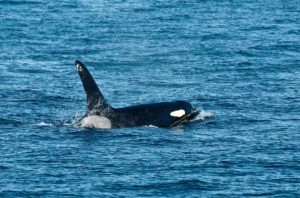If you’re in the Northwest, consider a whale watching cruise. We chose to sail with Island Adventure out of Anacortes, Washington.
On a brilliant sunny day, we sailed out through the San Jan Islands and into the Strait of Juan de Fuca.
The San Juan Islands are among the best places in the world to view orca and minke whales. The area is home to three pods of resident whales who are numbered and named. Orca whales have been returning to the area for hundreds of years and feed on Pacific Northwest salmon.
We cruised for a while before spotting our first whale, then we saw many as they cavorted in the water, expelling air through their blowholes as they fished for salmon. We saw many salmon jumping, probably trying to escape from their predators. The orca is a beautiful species with glossy black back and white belly, white eye patch, and grayish white saddle patch. The dorsal fin may be three to six feet long. The coloration of the orca’s dorsal fin and saddle patches are distinct, and these unique physical characteristics are used to identify individual whales. Adult orcas weigh 7,000 to 25,000 pounds, measure 17 to 32 feet, and can live 100 or more years.
During different times of the year, other whales—the minke, gray and humpback—also can be seen in these waters.
With each sighting, our on-board naturalist identified many of the orca by their pod names, J, K or L, and then their sub-groups consisting of mothers and offspring. We were able to observe a mother with her calf on several occasions as she showed off her baby to us. The boat kept a respectable, legal distance from the whales as required by law.
The orca is really not a whale at all, but is the largest member of the dolphin family. However, it is commonly called a whale because of its size and habits. The distinctive black and white orcas are probably the most studied group of marine mammals in the world. They are regarded by some scientists as the third most intelligent animal on the planet, after humans and chimpanzees.
Orca, sometimes called “killer whale” are an endangered species in Washington, Oregon and California. When viewing, observers should stay at least 200 yards away, using binoculars or cameras with zoom lenses for a closer view. If the wildlife approaches the boat, the engines should be placed in neutral, giving wildlife the right-of-way.
Whale watching tours are scheduled March through October. The orca population is decreasing at an alarming rate due to many factors. To learn more about whales and what can be done to protect this amazing mammal, visit whaleresearch.com


